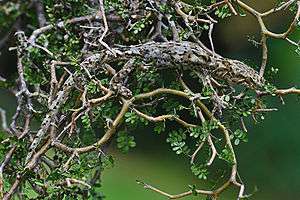Wildlife smuggling in New Zealand

New Zealand has a number of rare and endangered species and there have been cases of wildlife smuggling. New Zealand is a signatory to CITES (Convention on International Trade in Endangered Species of Wild Fauna and Flora) which was set up to ensure that international trade in specimens of wild animals and plants does not threaten their survival. CITES is administered by the Department of Conservation. Prosecutions from smuggling wildlife can be made under the Trade in Endangered Species Act 1989.
The Wildlife Enforcement Group, a three-person team drawn from three government departments (the New Zealand Customs Service, the Ministry of Agriculture and Forestry and the Department of Conservation), was set up in 1992 to investigate wildlife smuggling to and from New Zealand.[1] The WEG's activities led to 24 prosecutions, but the group was gradually disbanded between 2012 and 2014, and since that time there has been no dedicated task force policing wildlife smuggling in New Zealand.[2] There have also been no arrests or prosecutions for wildlife smuggling since 2012, despite strong evidence that it is occurring.[3][4]
Notable incidents
Incidents of smuggling in New Zealand include:
- In 1993 a light plane was used to smuggle 31 Australian birds, including two cockatoo species, into New Zealand. In "Operation Icarus" the police made a number of arrests with the eventual conviction of six people in New Zealand and another six in Australia.[5]
- In 1997 over 600 Australian birds were being smuggled through New Zealand destined for Europe, the United States, and Japan.[5]
- Freddie Angell was a recidivist wildlife smuggler who spent four years in jail for wildlife smuggling.[6]
- A German tourist was fined $12,000 for attempting to smuggle Northland green geckos out of the country in his underwear.[7]
- Two Czech botanists were convicted in 2004 of attempting to smuggle 363 wild plants, including 93 endemic orchids.[8]
- In January 2010 a German man who tried to smuggle 44 live geckos and skinks out of the country in his underwear was sentenced to 12 weeks in jail. He was caught trying to board a flight at Christchurch Airport with the animals.[9]
- In March 2010 two people were jailed for 18 weeks after taking jewelled geckos from the Otago Peninsula. They were arrested after a German man was found in Christchurch with 16 geckos in tubes in his backpack. He was sentenced to 15 weeks in prison.[10]
- Two Germans were jailed for four and a half months in March 2011 for attempting to smuggle jewelled geckos out of the country,[11] and in May 2012 a German man was jailed for 16 weeks after being found guilty of hunting and possessing four jewelled geckos.[12]
- In July 2017 a Marlborough green gecko was stolen from a terrarium at the Department of Conservation visitor centre in Fiordland National Park where he had lived for 30 years. No arrests were made and the gecko was not recovered.[13]
- In August 2017 a taped-shut lunchbox was discovered in the Christchurch Botanic Gardens containing 58 native lizards of various species, only 4 of which were still alive. This is likely to be the result of an unsuccessful smuggling attempt.[14][15]
See also
References
- ↑ Multi-agency effort to catch wildlife criminals
- ↑ Allott, Amber (25 August 2017). "New Zealand left without wildlife smuggling task force". New Zealand Herald. Retrieved 23 April 2018.
- ↑ Hancock, Farah (23 August 2017). "Three ways NZ can save its native geckos". Newsroom. Retrieved 23 April 2017.
- ↑ Hancock, Farah (29 November 2017). "Disbanding of NZ wildlife group paves way for poachers". Newsroom. Retrieved 23 April 2018.
- 1 2 TRAFFIC Oceania (April 1997). Trade in CITES-Listed Birds to and from New Zealand (PDF). Traffic Oceania. ISBN 9780958700818. Retrieved 5 May 2012.
- ↑ The Hidden World of Smuggling
- ↑ "Convicted Gecko smuggler gets [sic - error in title on source page]". New Zealand Government. 1 February 2001. Retrieved 30 June 2010.
- ↑ "TRAFFIC Bulletin Vol. 20 No. 1 (2004)" (PDF). TRAFFIC. 2004. p. 28. Retrieved 30 June 2010.
- ↑ "Tourist caught smuggling wildlife in underwear". New Zealand Customs Service. 8 December 2009. Retrieved 30 June 2010.
- ↑ Eriksen, Alanah May (30 June 2010). "Thousands for stolen geckos on European black market". New Zealand Herald. Retrieved 29 June 2010.
- ↑ Fox, Rebecca (7 May 2011). "Time to hit smugglers". Otago Daily Times. Retrieved 7 May 2011.
- ↑ Clarkson, David. "Andreas Hahn Pleads Guilty To Gecko Charges". The Press. 4 May 2012. Retrieved 5 May 2012.
- ↑ "Visitor centre gecko believed stolen". Otago Daily Times. 21 July 2017. Retrieved 23 April 2018.
- ↑ Fletcher, Jack (15 August 2017). "Nearly 60 native lizards found stuffed in a lunchbox at Christchurch Botanic Gardens". Stuff. Retrieved 23 April 2018.
- ↑ "DOC seeks information after lizards found". Department of Conservation Te Papa Atawhai. 15 August 2017. Retrieved 23 April 2018.
External links
- CITES page at the Department of Conservation
- New Zealand CITES-listed species
- TRAFFIC Oceania - wildlife trade monitoring network
- Hopkins, Steve (26 June 2011). "Black market in rare species costs NZ dearly". Stuff.co.nz. New Zealand. Retrieved 26 June 2011.
- Aynsley, B (1995). "Smugglers in Paradise". New Zealand Listener. New Zealand. 151 (2897): 18–21.